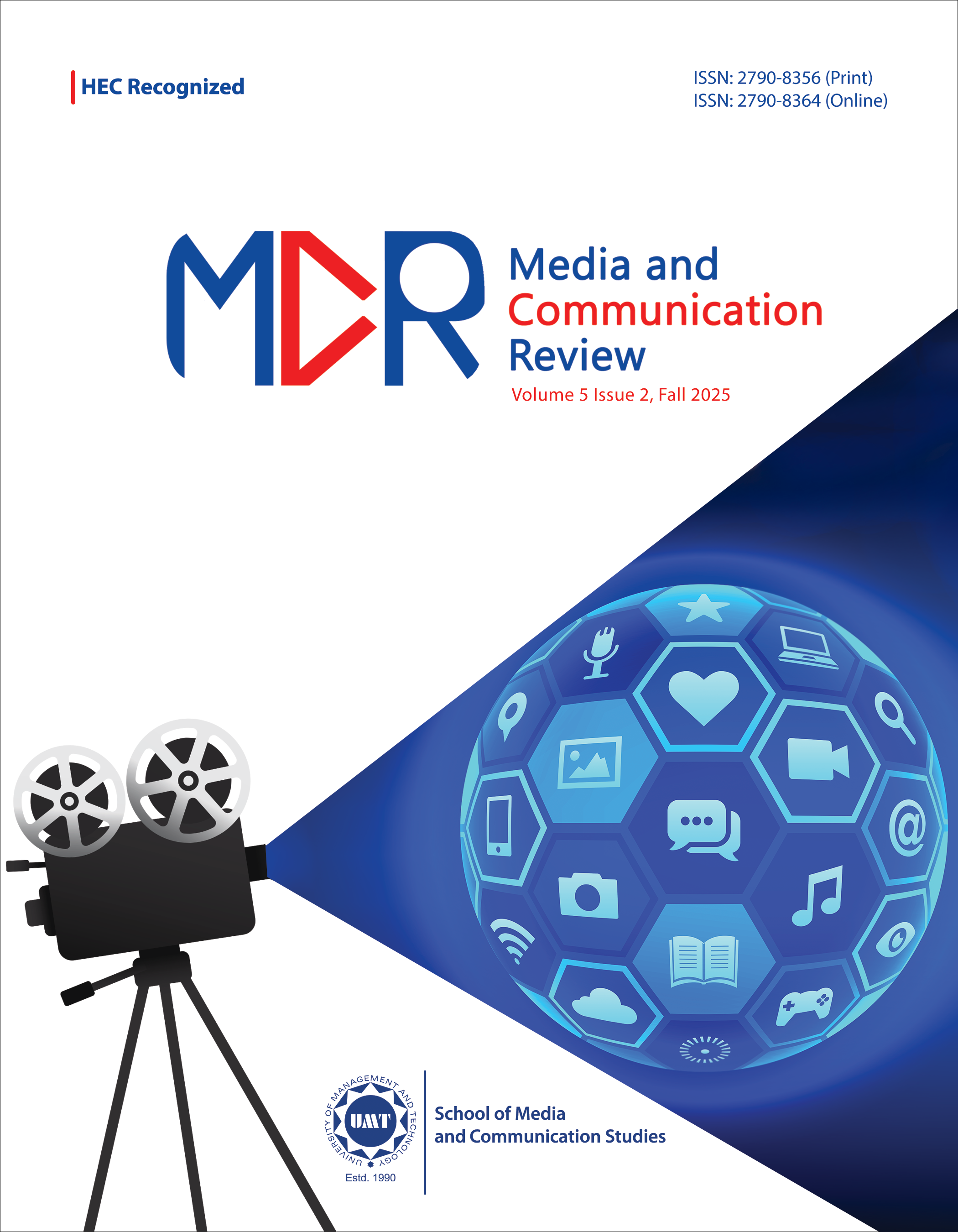The Price of Screen Time: How Prolonged Digital Exposure is Contributing to Rising Stress and Anxiety Among University Students
Abstract
 Abstract Views: 0
Abstract Views: 0
The study examines how screen time impacts university students' psychological state by evaluating their conditions related to stress, anxiety, depression and sleep patterns. Screen time has experienced an increase, mainly because of remote learning implemented during the COVID-19 pandemic, which researchers connect to deteriorating mental health conditions. Screen-related activities lead to fragile sleep quality, reduced physical exercise, and undesirable social relations, which combine to worsen stress and depression symptoms. Student behaviours that include watching complete shows in short periods tend to worsen procrastination and emotional withdrawal while causing social separation that diminishes mental wellness. The analysis indicates that psychological health is negatively impacted by excessive screen time, particularly when individuals surpass the recommended limits. The research indicates that sleep problems act as a connection between excessive screen time and mental health problems. The study demonstrates that healthy mental results need proper screen time regulation and outdoor activities. However, universities must establish programs to ensure both limitations in screen-time exposure and support for physical activity and wellness. Implementing these initiatives demonstrates the potential to enhance students' wellness conditions.
Downloads
References
Asgher, S., & Gohar, I. (2022). Binge watching on internet television networks & its effects on youth. Journal of Media & Communication, 3(1), 52–64.
Baiden, P., Tadeo, S. K., & Peters, K. E. (2019). The association between excessive screen-time behaviors and insufficient sleep among adolescents: Findings from the 2017 youth risk behavior surveillance system. Psychiatry Research, 281, Article e112586.
Baron, R. M., & Kenny, D. A. (1986). The moderator–mediator variable distinction in social psychological research: Conceptual, strategic, and statistical considerations. Journal of Personality and Social Psychology, 51(6), 1173–1182. https://doi.org/10.1037/0022-3514.51.6.1173
Brand, M., Wegmann, E., Stark, R., Müller, A., Wölfling, K., Robbins, T. W., & Potenza, M. N. (2019). The interaction of Person-Affect-Cognition-Execution (I-PACE) model for addictive behaviors: Update, generalization to addictive behaviors beyond internet-use disorders, and specification of the process character of addictive behaviors. Neuroscience and Biobehavioral Reviews, 104, 1–10. https://doi.org/10.1016/j.neubiorev.2019.06.032
Çayci, B. (2021). The effects of changing forms of watching TV series as a result of binge-watching on the viewers. Turkish Online Journal of Design Art and Communication, 11(2), 403–423. https://doi.org/10.36968/JPDC-V08-I02-27
Chen, Y., Li, Y., Li, S., He, M., Chen, Q., Ru, T., & Zhou, G. (2024). When and what: A longitudinal study on the role of screen time and activities in adolescent sleep. Sleep Medicine, 117, 33–39.
Cohen, J. (2016). A power primer. In A. E. Kazdin (Ed.), Methodological issues and strategies in clinical research (4th ed., pp. 279–284). American Psychological Association. https://doi.org/10.1037/14805-018.
Delong, D., Edmiston, D., College, V., & Hightower, R. (2014, March 26–28). Media bingeing: A qualitative study of psychological influences [Paper presentation]. Proceedings of Marketing Management Association Spring Conference, Chicago, IL.
Deyo, A., Wallace, J., & Kidwell, K. M. (2024). Screen time and mental health in college students: Time in nature as a protective factor. Journal of American College Health, 72(8), 3025–3032. https://doi.org/10.1080/07448481.2022.2151843
Garbóczy, S., Szemán-Nagy, A., Ahmad, M. S., Harsányi, S., Ocsenás, D., Rekenyi, V., Al-Tammemi, A. B., & Kolozsvári, L. R. (2021). Health anxiety, perceived stress, and coping styles in the shadow of the COVID-19. BMC Psychology, 9(1), Article e53. https://doi.org/10.1186/s40359-021-00560-3 .
Ge, Y., Xin, S., Luan, D., Zou, Z., Bai, X., Liu, M., & Gao, Q. (2020). Independent and combined associations between screen time and physical activity and perceived stress among college students. Addictive Behaviors, 103, Article e106224. https://doi.org/10.1016/j.addbeh.2019.106224
Hassan, A. A. U., Fazal, M., & Sheikh, M. A. (2024). Digital learning of children through YouTube: Perception of young parents in Lahore. Online Media and Society, 5(1), 25–35. https://doi.org/10.71016/oms/nhfafr21
Karuza, V. (2020). Why binge-watching? The prominent motives and analysis of the motivating hedonic and eudaimonic elements of emotional gratification in a binge-watching experience. Medijske Studije, 11(21), 3–23. https://hrcak.srce.hr/245564
Katz, E., & Blumler, J. G. (1974). The uses of mass communication: Current perspectives on gratifications research. Sage Publications.
Kondo, M. C., Jacoby, S. F., & South, E. C. (2018). Does spending time outdoors reduce stress? A review of real-time stress response to outdoor environments. Health & Place, 51, 136–150. https://doi.org/10.1016/j.healthplace.2018.03.001
Kottasz, R., Bennett, R., & Randell, T. (2019). Post-series depression: Scale development and validation. Arts and the Market, 9(2), 132–151. http://dx.doi.org/10.1108/AAM-02-2019-0009
Lavados-Romo, P., Andrade-Mayorga, O., Morales, G., & Muñoz, S. (2021). Association of screen time and physical activity with health-related quality of life in college students. Journal of American College Health, 71(5), 1504–1509. https://doi.org/10.1080/07448481.2021.1942006
Lee, S. S., Lingham, G., Wang, C. A., Torres, S. D., Pennell, C. E., Hysi, P. G., Hammond, C. J., Gharahkhani, P., Clark, R., Guggenheim, J. A., & Mackey, D. A. (2023). Changes in refractive error during young adulthood: the effects of longitudinal screen time, ocular sun exposure, and genetic predisposition. Investigative Ophthalmology & Visual Science, 64(14), 28. https://doi.org/10.1167/iovs.64.14.28
Lemenager, T., Neissner, M., Koopmann, A., Reinhard, I., Georgiadou, E., Müller, A., Kiefer, F., & Hillemacher, T. (2020). COVID-19 lockdown restrictions and online media consumption in Germany. International Journal of Environmental Research and Public Health, 18(1), Article e14. https://doi.org/10.3390/ijerph18010014
Li, C., Liu, D., & Dong, Y. (2019). Self-esteem and problematic smartphone use among adolescents: A moderated mediation model of depression and interpersonal trust. Frontiers in Psychology, 10, Article e2872. https://doi.org/10.3389/fpsyg.2019.02872
Liu, Q., Zhang, Y., Lin, Y., You, D., Zhang, W., Huang, Q., van den Bosch, C. C. K., & Lan, S. (2018). The relationship between self-rated naturalness of university green space and students’ restoration and health. Urban Forestry & Urban Greening, 34, 259–268. https://doi.org/10.1016/j.ufug.2018.07.008
Memon, M. A., Ting, H., Cheah, J. H., Thurasamy, R., Chuah, F., & Cham, T. H. (2020). Sample size for survey research: Review and recommendations. Journal of Applied Structural Equation Modeling, 4(2), 1–20. https://doi.org/10.47263/jasem.4(2)01
Oswald, T. K., Rumbold, A. R., Kedzior, S. G. E., & Moore, V. M. (2021). Mental health of young Australians during the COVID-19 pandemic: Exploring the roles of employment precarity, screen time, and contact with nature. International Journal of Environmental Research and Public Health, 18(11), Article e5630. https://doi.org/10.3390/ijerph18115630
Pittman, M., & Reich, B. (2016). Social media and loneliness: Why an Instagram picture may be worth more than a thousand Twitter words. Computers in Human Behavior, 62, 155–167. https://doi.org/10.1016/j.chb.2016.03.084
Pittman, M., & Sheehan, K. (2015). Sprinting a media marathon: Uses and gratifications of binge-watching television through Netflix. First Monday, 20(10). https://doi.org/10.5210/fm.v20i10.6138
Rosenthal, S. R., Zhou, J., & Booth, S. T. (2021). Association between mobile phone screen time and depressive symptoms among college students: A threshold effect. Human Behavior and Emerging Technologies, 3(3), 432–440. https://doi.org/10.1002/hbe2.256
Rubenking, B., Bracken, C. C., Sandoval, J., & Rister, A. (2018). Defining new viewing behaviors: What makes and motivates TV binge-watching? International Journal of Digital Television, 9(1), 69–85. http://dx.doi.org/10.1386/jdtv.9.1.69_1
Smith, L., Jacob, L., Trott, M., Yakkundi, A., Butler, L., Barnett, Y., Armstrong, N. C., McDermott, D., Schuch, F., Meyer, J., López-Bueno, R., Sánchez, G. F. L., Bradley, D., & Tully, M. A. (2020). The association between screen time and mental health during COVID-19: A cross-sectional study. Psychiatry Research, 292, Article e113333. https://doi.org/10.1016/j.psychres.2020.113333
Sohail, S. A., Mahmood, Q., Khan, M. H., & Gull, Z. (2019). Tinder use among Pakistani adults: a socio-psychological need perspective. Jurnal Studi Komunikasi, 3(3), 316–331.
Starosta, J. A., & Izydorczyk, B. (2020). Understanding the phenomenon of binge-watching—a systematic review. International Journal of Environmental Research and Public Health, 17(12), Article e4469. https://doi.org/10.3390/ijerph17124469
Sun, J. J., & Chang, Y. J. (2021). Associations of problematic binge-watching with depression, social interaction anxiety, and loneliness. International Journal of Environmental Research and Public Health, 18(3), 1168. https://doi.org/10.3390/ijerph18031168
Vaterlaus, J. M., Spruance, L. A., Frantz, K., & Kruger, J. S. (2019). College student television binge-watching: Conceptualization, gratifications, and perceived consequences. The Social Science Journal, 56(4), 470–479. https://doi.org/10.1016/j.soscij.2018.10.004
Woods, H. C., & Scott, H. (2016). #Sleepyteens: Social media use in adolescence is associated with poor sleep quality, anxiety, depression, and low self-esteem. Journal of Adolescence, 51(51), 41–49. https://doi.org/10.1016/j.adolescence.2016.05.008
Wu, X., Tao, S., Zhang, Y., Zhang, S., & Tao, F. (2015). Low physical activity and high screen time can increase the risks of mental health problems and poor sleep quality among Chinese college students. PLOS ONE, 10(3), Article e0119607. https://doi.org/10.1371/journal.pone.0119607
Yasir, A., Baloch, M., & Hassan, A. A. U. (2023). Disengagement of youth with student politics in Pakistan: A study of the experiences of politically engaged students. Research Journal for Societal Issues, 5(3), 274–284. https://doi.org/10.56976/rjsi.v5i3.155
Copyright (c) 2025 Nabeeha Rauf, Muhammad Salman, Kranthi Kumar Reddy Palem, Ayodeji Saraki

This work is licensed under a Creative Commons Attribution 4.0 International License.
Copyrights © Author(s) 2021




